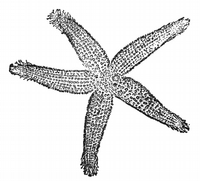The starfish and the spider

Tonight I participated in a book presentation by Rod A. Beckström on The Starfish and the Spider (side event at the Web 2.0 Expo Berlin). He started off with his motivation for writing this book, 9/11. Yes, Al-Quaida is an archetypical network, and mapping this decentralized network is quite a task.
Social Network Analysis shows us that the network of Al-Quaida is really well designed. And the point is that this isn’t an organization, it is an ideology streamlining and leveraging different and distributed islamic terror cells. The strength is in the shared ideas, not in the structure (i.e. processes).
Now an interesting slide, what do Geronimo, Wikipedia, myspace, craigslist, Alcoholics Anonymous, YouTube (and Bin Laden) have in common? They are all decentralized networks, these are not chaos, but a very singular structure.
Starfish can regrow – even from on single leg. It is self-sustaining, it has all it needs in one leg, so if you cut one leg off, it can work out to a starfish again.
Next one is cool, man in red tights, Hernando Cortez, burning the boats after landing. But that’s only the start: He invades the centralized Aztec empire, kills the whole royal family and eradicated the whole capital. Worked quite well, but here’s the catch: This didn’t work with the decentralized Apache society. Even when the Spanish managed to catch the leader it didn’t help – as there was just another leader ready.
if you attack a decentralized network you make it more decentralized and more vicious
Then Rod took us back into today, Napster vs. Big 5-music industry. Really good slide here, showing both the centralization of the industry into the big 5 music companies, and the post napster atomization of P2P-filesharing into KaZaa and even more decentralized networks.
Napster was an easy kill for the music industry, as it relied on central servers. KaZaa, eMule and BitTorrent they don’t rely on this, so it is really hard to get a grip.
Next up is Eric S. Raymond (The cathedral and the bazaar), the hybrid car (Combo special) Toyota Prius. Even when Toyota is a classic centralized company, they managed to put out this car – looks like a spider, acts like a starfish.
Next example: the Tesla electrical sports car (built by geeks). Wholly outsourced production, only R&D+design rests in the middle.
Now we’re going into wiki stuff, he’s introducing TWiki.net, his company that relies on the Twiki open source wiki project. While the company has to be somewhat more centralized than the community, it has got to collaborate with it.
Last, he’s offering some insights into different roles in this coopetitive setting, particularly catalysts (like e.g. Craig Newmark, see my posts here)
A Catalyst’s Tools
Genuine interest in others
Loose connections
Mapping
Desire to help
Passion
Meet people where they are […]
Emotional intelligence
Trust
Inspiration
Tolerance for ambiguity
Hands off approach
Receding
(via here, there are some excellent notes too)
And even more material and links on these ideas:





The Starfish and the Spider- der Seestern und die Spinne – dezentralisierte Organisationen…
The Starfish and the Spider %u2014 newthinking store
The book @ amazon.de
Martin Koser also blogged live.
My twitter notes, read from bottom to top:
beckstöm: twiki gets a company that is somewhat more centralized than the community but…
[…] Is there a person in charge? 2. Are there headquarters? 3. If you thump it on the head, will it die? 4. Is there a clear division of roles? 5. If you take […]
[…] für den Link zu Deinem Beitrag, das klingt ja nach einer sehr interessanten […]